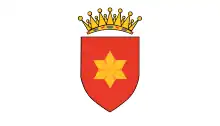Kingdom of Tavolara Regno di Tavolara | |
|---|---|
 Flag
 Coat of Arms
| |
 | |
| Status | Kingdom |
| Official languages | Sardinian, Italian |
| Ethnic groups | Sardinians |
| Demonym(s) | Tavolarese |
| Government | Monarchy |
• King | Giuseppe |
• King | Paolo II |
• King | Tonino Bertoleoni |
| Establishment | |
• Declared | 1836 |
| Area | |
• Total | 5 km2 (1.9 sq mi) |
| Population | |
• Estimate | 57 |
| Currency | Sardinian lira (to 1861) Italian lira (1861-2002) Euro (2002 on) |
The Kingdom of Tavolara is a purported micronation on Tavolara Island, off the northeast coast of Sardinia.[1] Set up by the Bertoleoni family, allegedly sanctioned by Charles Albert, King of Sardinia, it claims to be one of the smallest kingdoms in the world.
The island was known in ancient times as Hermea. According to tradition, Pope Pontian died on Tavolara following his abdication and exile in 235. It is probably the island previously called Tolar, which was used by some Arab ships in 848–849 as a base to attack nearby coasts.
Joachim Murat visited Tavolara in 1815 during his attempt to regain the Kingdom of Naples. At that time the island was uninhabited.
Giuseppe Bertoleoni claimed to be its monarch. When he died in the 1840s, his eldest son became King Paolo I. During his reign, in 1861 the Italian government paid 12,000 Italian lire for land at the northeast end of the island to build a lighthouse, which began operating in 1868.[2][3] After Paolo's death in 1886,[4] a number of newspapers published the report that according to his will, the island had become a republic. The New York Times described a government (supposedly recognized by Italy in 1887) with president and council of six elected every six years by a vote of the people, regardless of gender.[5] Others reported on Tavolara's alleged third presidential election in 1896.[6][7] These reports, however, did not end the Bertoleoni kingdom.[8] The third king of Tavolara was Carlo I, who was succeeded upon his death in 1928 by his son King Paolo II.[9] Paolo went abroad, however, and left Carlo's sister Mariangela as regent in his absence. Mariangela died in 1934, leaving the kingdom to Italy.[10] Her nephew Paolo II still claimed the kingdom until his death in 1962, a year that marked the installation of a NATO station on the island.
The present head of the Bertoleoni family is Tonino Bertoleoni, who runs "Da Tonino", a restaurant on the island. Politically, the interests of the micronation are represented in its external dealings by Ernesto Geremia of La Spezia, Liguria, Italy, who has written a history of the island.[11]
The tomb of Paolo I is in the graveyard on the island, surmounted by a crown.
See also
References
- ↑ Farinelli, Marcel (2021). "The Kingdom of Tavolara and the Republic of Malu Entu. Micronations, tourism and substate nationalism in two Sardinian near islands" (PDF). Transformations (35): 22–39.
- ↑ "La République de Tavolara". A travers le monde aux pays inconnus. Paris: Librairie Hachette. 1896. p. 176.
- ↑ "Notice to Mariners," London Gazette, Aug 28, 1868, p 4734
- ↑ "E morto il Re!" La Sardegna, June 8, 1886, p 1
- ↑ "Smallest State in the World" (PDF). New York Times. June 19, 1896. p. 6.
- ↑ "Tiny Nation to Vote: Smallest Republic in the World to Hold a Presidential Election," Lowell Daily Sun, Sep 17, 1896
- ↑ "Nation of 55 People: Republic of Tavolara in Its Third Presidential Campaign" Boston Globe, Jan 10, 1897, p 34
- ↑ Meissner, Hans Otto (1963). Unknown Europe. trans. Florence and Isabel McHugh. London and Glasgow: Blackie & Sons. p. 23.
- ↑ "Tavolara's King Dies; Ruled Tiniest Realm; Charles Bartoleoni Was Monarch of Small Island Off Sardinia's Coast". New York Times. February 1, 1928. p. 27. Retrieved 7 September 2009.
- ↑ "Italy Gets Queen's Island of Tavolara," Hartford Courant, July 9, 1934, p 15
- ↑ Geremia, Ernesto Carlo, and Gino Ragnetti (2005), Tavolara – l'Isola dei Re, ISBN 88-425-3441-2
Sources
- Geremia, Ernesto Carlo; Gino Ragnetti (2005). Tavolara – l'Isola dei Re. ISBN 88-425-3441-2.
External links
- Fioretti, Ovidio, "La corona senza reame," Archived 2021-01-27 at the Wayback Machine Almanacco di Cagliari 1989
- "Ocean wildlife [credits to MassimoBolognaItaly]". YouTube. Archived from the original on 2021-12-11.
- "Geography [Credits to MassimoBolognaItaly]". YouTube. Archived from the original on 2021-12-11.
- Flag of Tavolara
- BBC: The World's Smallest Kingdom
- Tonino Bertoleoni, King of Tavolara